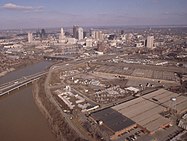Scioto Audubon Metro Park
Scioto Audubon Metro Park is a public park and nature preserve in Columbus, Ohio. The park is managed by the Columbus and Franklin County Metro Parks and is part of the Scioto Mile network of parks and trails around Downtown Columbus. The park features numerous trails, wetlands, rock climbing, volleyball and bocce courts, and numerous other amenities. At the western edge is the Grange Insurance Audubon Center, considered the first nature center built in close proximity to a downtown area.
| Scioto Audubon Metro Park | |
|---|---|
 The park's central activity area | |
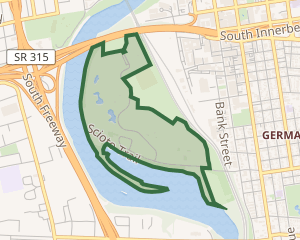
| |
| Location | 400 W. Whittier St, Columbus, Ohio |
| Coordinates | 39°56′57.242″N 83°0′31.990″W |
| Area | 120 acres (49 ha) |
| Opened | 2009 |
| Owned by | City of Columbus[1] |
| Administered by | Columbus and Franklin County Metro Parks |
| Visitors | about 800,000 annually[2] |
| Parking | Multiple lots |
| Public transit access | |
| Website | Official website |
The site was formerly industrial, and required extensive remediation. Planning began in 2003, and the park opened in 2009 with 94 acres (38 ha), later expanded to 120 acres.
Attributes
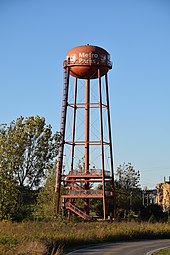
Scioto Audubon Metro Park is located on Columbus's Whittier Peninsula. It borders the Brewery District to the east, Interstate 71 and the Scioto River to the north and west, and downtown to the northeast, and it is partially isolated by railroad tracks. The park is a 10-minute walk from downtown, and gives views of the city skyline.[3] It was designed by MKSK, an urban planning and landscape architecture company that has made many Columbus-area works, including the Scioto Mile.[4]
Specific features include a central activity area, with a climbing wall, water tower with two observation platforms, and three sand volleyball courts. The park also has a 2.5-acre (1.0 ha) dog park, an obstacle course with nine stations, and seven small wetlands of about 5 acres (2.0 ha) total. Nearby are recreation fields, a sledding hill, butterfly garden, bocce courts, a park office and visitor center, a boat ramp, fishing docks, and a maintenance area. The park includes multiple restrooms, picnic tables, grills, and parking lots. The nearby Greenlawn Avenue dam widens the river into a slack water lake, attractive to migrating birds. Thousands of birds utilize the area during spring migrations, including over 200 species. The park is an Important Bird Area, named by Audubon and BirdLife International. The Columbus Rotary Obstacle Course has an 8-foot wall, cargo rope climb, balance beams, monkey bars, a tunnel crawl, and a belly crawl. The park features four trails: the Hermit Thrush Trail has 0.125 miles through forest, the Columbus Rotary Running Track is 0.5 miles, and the Wetland Trail is 0.4 miles. The longest is the Scioto Greenway Trail, which runs through the park for about 2 miles. It also connects north to the Olentangy Trail, which runs 14 miles to Worthington.[3][5]
The Metro Park climbing wall is 35 ft (11 m) high, made of fiberglass, with three towers and two arches. The 6,100 sq ft (570 m2) structure is considered the largest free outdoor climbing wall in the United States. The wall can handle up to 20 climbers at a time, and can be used for used for bouldering as well as lead and top-rope climbing. Although access to the wall is free, climbers are required to bring their own gear.[3]
The butterfly garden, planted in 2016, has seven raised mounds and a wide variety of plants aimed to attract 40 different butterfly species, as well as bees, wasps, and beetles. The plants include shrubs, annuals, grass, milkweed and perennials. The garden is considered the largest butterfly garden in the Metro Parks system.[6]
Scioto Audubon Metro Park operates year-round, with varying hours in different seasons.[3] 2014 attendance was over 800,000, beyond the park attendance expected by the Metro Parks director.[2]
Audubon Center

The Grange Insurance Audubon Center is located near the western edge of the park, at 505 W. Whittier St. The 18,000 sq ft (1,700 m2) building is the first Audubon center built in close proximity to a downtown area. It was built along with the park, opening in August 2009 at a cost of $14.5 million. It is managed by Audubon Ohio, and is one of about 50 of their centers in the United States. It includes classrooms, a library, 200-seat auditorium, demonstration gardens, and an observation room for birding. The building, designed by DesignGroup, was made to be environmentally-friendly. It uses a passive solar design, native plants on its green roof, and it maximizes natural light, uses geothermal heating, and has gutters leading to bioswales, filtering debris and pollution out of runoff. It has a LEED Gold rating from the U.S. Green Building Council.[7][3]
Originally, Audubon planned to spend $8 million on the facility. Philip Urban, then CEO of Grange Insurance, was looking for an iconic way for his company to commemorate 75 years in business. The company agreed to purchase the facility's naming rights for $4 million. Urban then formed a fundraising committee and convinced corporations and individuals to contribute, raising the total funds to $14.5 million.[1]
Important Bird Area
The Scioto Audubon makes up part of the Scioto River-Greenlawn Important Bird Area, a three-mile riparian corridor in the city. The area also includes the 360-acre Green Lawn Cemetery and the Lou Berliner Sports Park. The corridor has had more recorded bird species than any other stretch of the Scioto, numbering 212 species.[8]
Species include the northern pintail, pied-billed grebe, American bittern, osprey, at least ten species of gulls and terns, the prothonotary warbler, northern waterthrush, peregrine falcons, bald eagles, cliff swallows, red-shouldered hawks, red-headed woodpeckers, and the yellow-crowned night heron.[8]
Neighboring features
Branching out of the park is an abandoned overpass, spanning over the nearby I-70 and I-71. In 2020, a 400-foot mural was painted on its roadbed, reading "We are stronger together", in reference to the ongoing coronavirus pandemic.[9]
The park borders an electrical substation, noted for containing three large stone monoliths. An environmental site assessment by the Ohio Department of Transportation noted their presence and lack of identifying features.[10]
History
The entire Whittier Peninsula was once home to factories, rail yards, warehouses, and impound lots, and it became an industrial brownfield site.[3] In the early 2000s, Columbus looked to redeveloping its riverfront, as many other cities were at the time. The Whittier Peninsula was proposed to be used for ballparks or an amphitheater. Conservationists helped push for the current park, as the site was being used for birdwatching even then. A three-mile area along the Scioto River still retained its forest, and had been recently designated an Important Bird Area. In 2003, Columbus Metro Parks, the Columbus Recreation and Parks Department, and Audubon Ohio signed an agreement to create the park. The city had to remove old buildings and underground storage tanks, and pay for soil remediation. Lead and arsenic were concerning, but the five acres around the Audubon center site were not of concern given low levels and contaminants buried deep enough.[1]
The park opened August 28, 2009, at a cost of $14 million, including $11 million to purchase the land and clean up contamination.[3][11] The park's obstacle course opened in 2013.[2] In 2015 and 2016, the park was home to the annual American Birding Expo, hosted by Bird Watcher's Digest.[12]
Gallery
_(COAF)_-_5926263441.jpg) Site during redevelopment, c. 2010
Site during redevelopment, c. 2010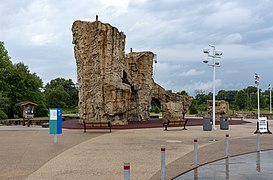 Climbing tower
Climbing tower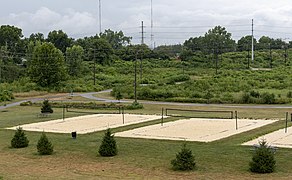 Volleyball courts
Volleyball courts Restored wetlands and Wetland Trail
Restored wetlands and Wetland Trail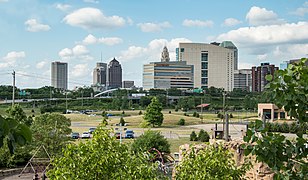 City view
City view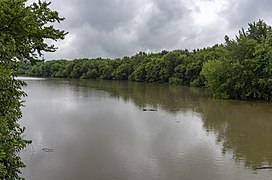 Scioto River inlet
Scioto River inlet_-_6377531285.jpg) Park office
Park office
See also
References
- "An Industrial Brownfield In Ohio Gets a Makeover Fit for Birds". Audubon. November 16, 2012.
- Dispatch, Mark Ferenchik, The Columbus. "Metro Parks expect record year". Columbus Alive.
- "Scioto Audubon Metro Park: A recycled green oasis near downtown Columbus". Akron Beacon Journal.
- https://www.bizjournals.com/columbus/news/2018/11/26/making-a-full-necklace-out-of-disconnected-pearls.html
- "Scioto Audubon Park Map".
- https://www.thisweeknews.com/content/stories/canalwinchester/news/2016/03/28/scioto-audubon-park-butterflies-expected-to-flutter-by-new-garden.html
- "Grange Insurance Audubon Center | Explore Columbus". u.osu.edu.
- https://www.audubon.org/important-bird-areas/scioto-river-greenlawn
- Dispatch, Nancy Gilson For The Columbus. "Columbus artists adorn abandoned I-70/I-71 overpass with giant mural". The Columbus Dispatch.
- "11-8" (PDF).
- https://www.thisweeknews.com/content/stories/dublin/news/2009/08/26/0826ducenter_ln.html
- https://www.pennlive.com/wildaboutpa/2017/09/largest_birdwatching_bird-feed.html
External links
| Wikimedia Commons has media related to Scioto Audubon Metro Park. |
- Official website
- Grange Insurance Audubon Center
- Scioto Mile page
- Perceptions of Constructed Native Landscapes: A Case Study of Scioto Audubon Metro Park
